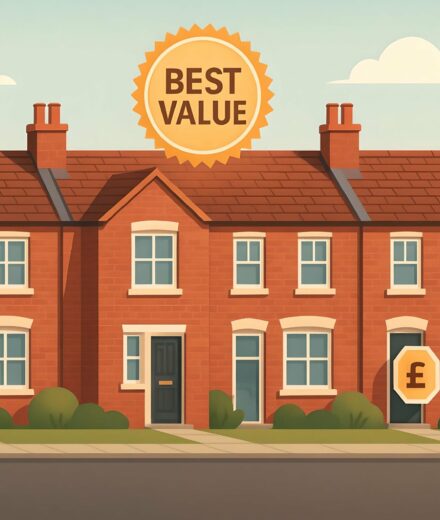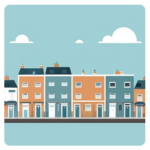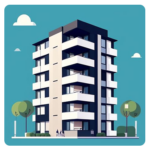

View how property transactions in Carlisle have shifted over time by housing category, with figures split by district and neighbouring towns.
You’ll also see whether Carlisle is experiencing balanced growth or isolated hotspots when viewed alongside local peers.
House Prices > Carlisle
| Year | Average Price | Transactions |
|---|---|---|
| 2025 (proj.) | £188,100 | 2,158 |
| 2024 | £183,800 | 1,586 |
| 2023 | £187,300 | 2,021 |
| 2022 | £187,900 | 2,278 |
| 2021 | £180,400 | 2,757 |
| 2020 | £176,100 | 1,980 |
| 2019 | £164,200 | 2,190 |
| 2018 | £160,200 | 2,294 |
The Carlisle property market moves in mysterious ways, much like the city’s wild weather. One moment there’s a surge in property transactions, the next, a gentle lull. Price growth has been both alluring and fickle, depending on where you’re standing.
So, what should buyers and sellers remember? Carlisle’s “typical” year is anything but typical. Shrewd locals know that timing and street-by-street knowledge matter more here than in most places.
Checking what homes go for in Carlisle? Here's the up-to-date list of properties available to buy in Carlisle.

Avg. Property Price: £282,300
Avg. Size of Property
1,322 sq/ft
Avg. Cost Per Sq/ft
£220 sq/ft
Total transactions
1,103 (since 2021)

Avg. Property Price: £159,600
Avg. Size of Property
923 sq/ft
Avg. Cost Per Sq/ft
£176 sq/ft
Total transactions
2,021 (since 2021)

Avg. Property Price: £121,900
Avg. Size of Property
943 sq/ft
Avg. Cost Per Sq/ft
£131 sq/ft
Total transactions
2,464 (since 2021)

Avg. Property Price: £96,800
Avg. Size of Property
683 sq/ft
Avg. Cost Per Sq/ft
£140 sq/ft
Total transactions
173 (since 2021)
Carlisle’s property market can appear as straightforward as the city’s railway station at first glance, yet a closer look uncovers striking differences between property types. Behind the average price tags, it’s easy to be lulled by what seems “affordable” on paper, but the reality for buyers is often quite a bit trickier.
Start with detached houses. On paper, they offer the most space and the grandest sense of privacy. But the purchase price, when spread out over 1,310 sq/ft, rings up at a rather weighty £220 per square foot. That sounds reasonable for those with sizeable budgets, though for many first-time buyers in this part of Cumbria, securing the keys to a detached home can feel like finding a golden ticket on Lowther Street. Then again, there’s no ignoring that the volume of 1,086 transactions since 2021 barely dents demand, hinting at a persistent bottleneck for those who want space above all else.
The semi-detached segment is no less intriguing. With their distinctive, classic look and practical footprint, these homes lure “second steppers” and young families alike. But the 2,013 transactions since 2021 may outshine all, underscoring a chronic, if not frantic, chase for this sweet spot between price and practicality. Yet, with a £180 per square foot tag attached, some might question whether buyers are truly getting a bargain or if they’re just sidestepping steeper detached prices for compromises in space.
Terraced homes have long been Carlisle’s backbone for working families and investors, but their supposed affordability might not stretch quite as far as it did a decade ago. Despite the largest number of 2,452 recent sales, the cost-per-foot metric sits at a modest £130, yet the average 940 sq/ft makes some of these houses feel more cramped than cosy. For some, these homes are a foot in the door, for others, a long-term squeeze that is simply the price of staying within the city’s boundaries.
Then there are the flats – prime for singles, students, and those undaunted by smaller footprints. Prices here are lower, but that headline can be misleading. At a mere 680 sq/ft and an average price equivalent to £140 per square foot, buyers are often trading flexibility and individuality for sheer affordability. The whisper-thin volume of 173 post-2021 sales whispers of muted demand, despite (or perhaps because of) their modest price tags.
Sceptical buyers should scrutinise beyond averages. While Carlisle routinely ranks as one of England’s more affordable cities (see where it sits on the national scale here), these numbers hardly tell the whole story for anyone actively making offers in a market that moves unevenly by type, street, and neighbourhood.
In Carlisle, securing the “right” property is rarely a smooth ride – and often feels as unpredictable as the weather blowing in from the Solway Firth.
| District | Avg Price (£) | Transactions |
|---|---|---|
| CA1 | £145,100 | 3,757 |
| CA2 | £137,600 | 5,623 |
| CA3 | £197,600 | 2,472 |
| CA4 | £282,200 | 1,464 |
| CA5 | £275,400 | 842 |
| CA6 | £226,700 | 1,060 |
Carlisle’s property market has a unique flavour — shaped by its historic neighbourhoods, rolling countryside, and the gentle pulse of its riverside life. Comparing the districts side by side, you’ll find a story as diverse as the city’s own heritage, with everything from modest terraces to stately stone cottages on offer.
In the city’s heartier, established areas, prices are refreshingly approachable. These places wear their history proudly, making them handy for first-time buyers, young professionals, or families looking to plant their roots without stretching the budget too thin. You truly get a sense of place here — cobbled lanes and timeworn shopfronts, where every street has its own story.
As you wander outwards towards the city’s ancient boundaries and leafy outposts, property prices begin to climb — and for good reason. These desirable pockets offer a slice of country living within easy reach of the centre. The higher average prices in these areas tell a clear story: space, privacy, and scenery are qualities much cherished by buyers. The housing here attracts those seeking a quieter lifestyle, with stone farmhouses and handsome detached homes standing amid meadows as lush as a Cumbrian summer.
Numbers also reveal that the more affordable districts are alive with steady transaction activity, showing a nimble, bustling local market. In these places, you can almost imagine the market simmering like a hearty stew, gaining richness and warmth every season. Further out, fewer sales go through overall, as these choices tend to appeal to long-term movers or those finally making that dream rural leap.
It’s also clear these price differences mirror the wide variety in Carlisle’s housing stock, from Victorian terraces close to the cathedral, to modern builds with sweeping Eden Valley views. Buyers set on discovering where their money stretches farthest will want to compare more than postcode alone. Explore where property is still affordable in Carlisle today.
Carlisle’s property market continues to simmer steadily, with each neighbourhood offering its own blend of tradition, scenery, and value. The city is proof that where you buy isn’t just about price — it’s about finding your place in a living, breathing, proudly storied community.
Please also check out the following areas in Carlisle for further insights:
| City | Avg Price (£) | Transactions |
|---|---|---|
| Brampton | £232,100 | 814 |
| Wigton | £193,500 | 1,416 |
| Penrith | £249,900 | 3,854 |
| Keswick | £364,500 | 745 |
| Cockermouth | £249,900 | 1,656 |
| Maryport | £138,800 | 1,080 |
| Appleby-In-Westmorland | £222,500 | 576 |
| Workington | £141,000 | 2,725 |
If Carlisle’s property values were a set of cakes at a Cumbria village fete, you’d find a curious mix: some towering creations that catch every eye, some unassuming bargains that vanish before the kettle’s boiled. Buyers circling this city face a colourful patchwork of nearby options—each with its own appetite for attention.
If you’re sizing up Carlisle or its neighbours, clarity is key. The region caters for nearly every taste and budget. The real question: are you in the market for stardust sunsets over Derwentwater, or just happy with a solid roof and a chippy nearby?
Please note, these figures highlight average prices and total transactions without adjusting for property sizes.
Property size and cost per square foot are not factored in, meaning some shifts may be missed. To explore further, visit our blog.
Every valuation we show is drawn from officially logged transactions, carefully filtered through our smart refinement process. Outliers are removed, biases are reduced, and clarity is restored.
Our site uses cookies. By using this site, you agree to the Privacy Policy and Terms of Use.